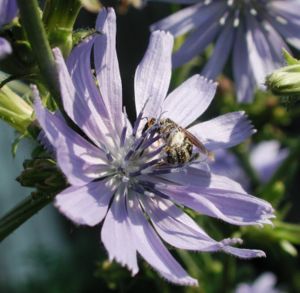Chicory: Difference between revisions
Jump to navigation
Jump to search

imported>Petréa Mitchell (Written by me, various sources) |
imported>David L Green (add photo) |
||
| Line 3: | Line 3: | ||
'''Chicory''' and '''curly endive''' are common names for the edible [[perennial]] [[herb]] ''[[Cichorium]] intybus''. | '''Chicory''' and '''curly endive''' are common names for the edible [[perennial]] [[herb]] ''[[Cichorium]] intybus''. | ||
The leaves have a bitter taste, and are used as [[salad greens]]. The roots can be eaten boiled, or can be roasted and ground to produce a flavoring for [[coffee]]. Some roots are also used for [[livestock]] feed. | The leaves have a bitter taste, and are used as [[salad greens]]. The roots can be eaten boiled, or can be roasted and ground to produce a flavoring for [[coffee]]. Some roots are also used for [[livestock]] feed. As a wildflower, it is also known as "ragged blue sailor." | ||
[[Image:Halictid bee 7702.JPG|thumb|right|Halictid bee|Chicory blossom with halictid bee pollinator|300 px]] | |||
Revision as of 16:22, 26 April 2008
Chicory and curly endive are common names for the edible perennial herb Cichorium intybus.
The leaves have a bitter taste, and are used as salad greens. The roots can be eaten boiled, or can be roasted and ground to produce a flavoring for coffee. Some roots are also used for livestock feed. As a wildflower, it is also known as "ragged blue sailor."
